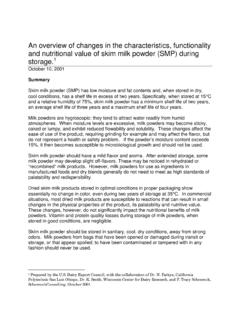Transcription of NONFAT DRY MILK (NFDM), SKIM MILK POWDER (SMP)
1 NONFAT DRY milk ( nfdm ), skim milk POWDER (SMP) Basic guidelines for composition, physical and chemical aspects Product Definition NONFAT dry milk (as defined by FDA/CFR) is obtained by removing water from pasteurized skim milk . It contains 5% or less moisture (by weight) and or less milkfat (by weight). By removing moisture to the greatest extent possible, microbial growth is prevented. NONFAT dry milk is classified for use as an ingredient according to the heat treatment used in its manufacture. There are three main classifications: high heat (least soluble), medium heat, and low heat (most soluble). Extra grade NONFAT dry milk powders are available in roller dried and spray dried form, the latter being the most common. NONFAT dry milk powders are available in two forms: ordinary or non-agglomerated (non-instant) and agglomerated (instant). The Codex Alimentarius, in its standard 207-1999, describes milk powders and cream POWDER as milk products which can be obtained by the partial removal of water from milk or cream.
2 The fat and/or protein content of the milk or cream may have been adjusted to comply with the compositional requirements of the standard, but the addition and/or withdrawal of milk constituents in such a way as not to alter the whey protein to casein ratio of the milk being adjusted. milk retentate, milk permeate and lactose are allowed for protein adjustment purposes. The Codex Alimentarius standard sets compositional criteria for skimmed milk POWDER which are: maximum milk fat: m/m, maximum water: 5% m/m, and minimum protein in milk solids non fat: 34% m/m. the standard also makes provision for the use of additives: stabilizers (sodium and potassium citrates, no more than 5 g/kg), firming agents (potassium chloride and calcium chloride, limited by GMP), acidity regulators (5 g/kg), emulsifiers, anti-caking agents and antioxidants. milk powders should also comply with the maximum limits established by the Codex Alimentarius Commission. In it Annex, the standard references additional quality factors and methods of analysis recommended by the International Dairy Federation.
3 Storage Ship and store in a cool, dry environment at temperatures less than 27 C and relative humidity less than 65%. The shelf life of non-instant skim milk POWDER is 12-18 months, instant is 6-12 months. Note that storage life is very dependent on storage conditions and this figure is only a guide. Under ideal conditions, non-instant skim milk POWDER can retain its physical and functional properties for at least two years; however quality will be impaired if temperatures and humidity are too high and storage is extended. Typical Composition Protein Lactose Fat Ash Moisture (non-instant) (instant) Physical and Chemical Aspects Typical Microbiological Analysis Standard Plate Count <10,000 cfu/g* Coliform 10/g (maximum) E.
4 Coli Negative Salmonella Negative Listeria Negative Coagulase-positive Staphylococci Negative Other Characteristics Scorched particle content (spray dried) (roller dried) mg mg Titratable acidity mg Solubility index (instant) (spray dried, low heat) (high heat) (roller dried) ml ml ml ml Color White to light cream color Flavor Clean, pleasing dairy flavor *Extra grade NONFAT Dry milk Typical Nutritional Composition Per 100 g NONFAT Dry milk ,with added Vitamin A Per 100 g NONFAT Dry milk , Instant Nutrient Water Energy 362 Kcal, 1516 KJ 358 Kcal, 1498 KJ Protein g g Lipid g g Carbohydrate (by difference)
5 G g Fiber, total dietary g g Ash g g Minerals Calcium 1257 mg 1231 mg Iron mg mg Magnesium 110 mg 117 mg Phosphorus 968 mg 985 mg Potassium 1794 mg 1705 mg Sodium 535 mg 549 mg Zinc mg mg Copper mg mg Manganese mg mg Selenium g g Vitamins Ascorbic acid mg mg Thiamin mg mg Riboflavin mg mg Niacin mg mg Pantothenic acid mg mg Vitamin B6 mg mg Folate 50 g 50 g Vitamin B12 g g Vitamin A, IU 2179 4 Vitamin A, RE 653 g 4 g Vitamin E, apha-tocopherol mg mg Lipids Saturated, total g g Monounsaturated, total g g Polyunsaturated, total g g Cholesterol 20 mg 18 mg Amino Acids Tryptophan g g Threonine g g Isoleucine g g Leucine g g Lysine g g Methionine g g Cystine g g Phenylalanine g g Tyrosine g g Valine g g Arginine g g Histidine g g Alanine g g Aspartic acid g g Glutamic acid g g Glycine g g Proline g g Serine g g Source: Reference Manual for milk Powders.
6 Arlington, VA: Dairy Export Council, 2005. p32-34. This product has been inspected by the United States Department of Agriculture (USDA) and meets all applicable quality standards for food grade products according to USDA and Food and Drug Administration provisions.

